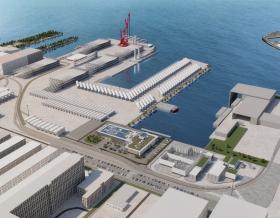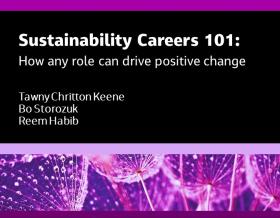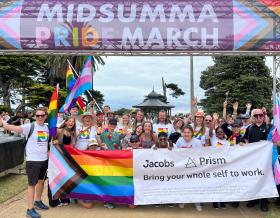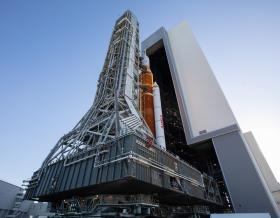
Programs are increasing in complexity and scale, and it’s driving a construction boom. According to Oxford Economics, global construction output is expected to grow by 42% or USD $4.5 trillion between 2020 and 2030, ultimately reaching USD $15.2 trillion.
Within this growth potential, the key challenge is to earn results that reward a triple bottom line of people, planet and profit. Our program management framework achieves this through a blend of innovation, global collaboration and a strategic, market-leading mix of talent and technology.
Anna James’ career has included several pivotal North American programs, including San Mateo, California’s Clean Water Program and San Francisco’s Waterfront Resilience Program, and her maturity assessments are helping to raise the standards and pioneer global best practices.
In this article, Anna describes how her inclusive leadership style empowers her teams, strengthens client partnerships and leverages the latest data-driven trends.
Hi, Anna. Tell us about your background.
I grew up in the Midwest U.S., where I attended the University of Michigan for civil and environmental engineering, and then moved to Chicago, Illinois, where I joined Jacobs. I’ve now been with Jacobs for almost 12 years.
Most of my work has been with large programs, the first a watermain replacement program in Chicago. Since then, I've been lucky to do a wide variety of work — including detailed design and planning — but for the last ten years, I've focused mainly on program management and operations.
Internally, I manage a talented water and wastewater team in Jacobs’ San Francisco office; externally, I work on several large programs in California.
I’m grateful to lead maturity assessments for our programs in the Americas, which provide a framework to explore how our programs are doing, investigate how robust the functional areas are and compare them with benchmarks. It goes far beyond performance; uncovering opportunities and allowing leaders to develop their teams. These assessments help instill continuous adaptation and growth — it’s a critical tool to keep teams performing at the highest levels and prevent programs from stagnating.
I prefer to do these assessments as often as possible, as the programs of this scale are everchanging and require agile project delivery teams and creative collaboration. They systematically address any issues and preempt any gaps or shortcomings.
I love our work — implementing these vast infrastructure projects that affect people daily (directly or indirectly) is invigorating.
How is your team solving some of your biggest client challenges?
For me it all starts with strategic, inclusive collaboration. For example, our work on San Francisco's Waterfront Resilience Program deals with some of the greatest global challenges, including the effects of climate change, rising sea levels and seismic resilience at the waterfront in the Bay Area in Northern California. The solutions for programs like this aren’t one-size-fits-all; they demand much higher levels of tailored stakeholder engagement and creative problem-solving with clients involved at every step.
Besides customized planning and strategy, we provide access to the right technical experts and cutting-edge technologies at the right time. At Jacobs we combine this with proven decision-making frameworks and governance best practices so we can empower our clients to make the right decisions at the right time.
Lastly, we rely on global connectivity and the cross-sector talent of our teams. We’re constantly sharing lessons and harnessing the best talent at a moment’s notice.
What are your key insights from your major program experience?
The plan before the plan always matters. As engineers, we often want to spend time doing, designing or implementing, but what I've learned is the more time you spend planning — whether it's implementation or program initiation— and bringing your client along, the better the execution will be. It’s critical to hammer it all out as early as possible, including all the tiny, seemingly insignificant details with clients. Things will change as the program progresses, but the more detailed and thoughtful the plan, the stronger the foundation and client education.
This planning produces a baseline scope that acts as an initial diagnostic right at the beginning. It’s integral to all decision-making and vital to mitigate impacts to your scope, schedule and budget.
This planning needs to be tailored to suit your client’s needs and preferences. I’ve worked with clients who are receptive and open to planning and others on the opposing side of the spectrum who only want results. The solution is to spend time understanding who the programmatic stakeholders are, how they want to make decisions, and the best way to document them. It is time-consuming, but the rewards make it worthwhile, especially within programmatic governance and when you’ve done it early in the cycle. Understanding how organizations make decisions is critical to successfully delivering programs.
Lastly, testing should be hard-baked into your culture. Maturity assessments are vital, but they are only one example; all teams must periodically assess what is working (or not working), especially in terms of governance and decision-making, so that the program can continue to grow and adapt throughout its cycle.
“As engineers, we often want to spend time doing, designing or implementing, but what I've learned is the more time you spend planning — whether it's implementation or program initiation— and bringing your client along, the better the execution will be. ”
What are the key trends influencing major program delivery in the future?
- A demand for global connectivity: It’s a competitive edge for Jacobs thanks to our cross-sector collaboration, access to global talent and ability to stand up teams quickly. This will become even more critical with the bigger, more complex infrastructure challenges we’ll face in the future.
- Rapid upskilling within key tech-driven skills: Using the latest digital solutions, artificial intelligence and automation is no longer a goal; it’s a necessity. However, to get the best out of the technology, you need empowered, motivated talent with the right mix of soft and hard skills, including leadership and creative problem-solving. Continuous education, agile careers and a mentoring culture are all essential.
- Attracting the next generation of leaders: Engineers and project managers are in short supply across all sectors, and we’re competing against lucrative industries such as banking and finance. I see this war for talent daily here in San Francisco. It’s a constant challenge for engineering companies to offer the right roles, challenges and mentors for their younger employees to grow and thrive — like those I’ve been privileged to have.
How do you provide social value through major programs?
I’ve learned what a privilege it is to have this role, but comes with a profound responsibility. My experience in the San Francisco Bay Area has shown me how much the communities care about the implementation of these programs. It’s critical to engage communities through robust public outreach efforts; it’s a key factor in ensuring our work is unlocking the social value they deserve. As an engineering student, I never would have thought engagement would have such a massive impact on our work and success.
To do this, you must tailor your stakeholder engagement channels and methods to suit different communities. For example, in the Bay Area, a tactic that works in San Francisco wouldn't work for a community on the Peninsula. There’s even a difference between neighboring communities in the City of San Francisco that are separated only by a few blocks — engaging with each of these communities can require vastly different approaches. You must tailor your engagement strategies to accommodate and appreciate the diversity.
What is your proudest career moment?
I have loved working on our transformative planning efforts on the San Francisco waterfront, as it’s helping to respond to critical issues like sea level rise and seismic risks.
The second project moment I’m most proud of is when we broke ground on the treatment plant in San Mateo, which was the culmination of intense planning, creative collaboration and hard work. It was a tribute to the incredible quality of the people involved and the pioneering best practices we created for our clients and the communities. Aligned with this work for San Mateo was our contribution to the Clean Water Program. I led the closing of three huge low-interest, competitive loans which will help to save millions of dollars in financing costs in the long term.
What leadership lessons have you learned through your program experience?
- There isn’t one ideal leadership type — you need to lean into your own style. I’m an introverted leader, and initially, I found it to be a challenge, but thanks to my mentors’ input and feedback from other introverts, I’ve realized I’m a different type of leader who likes to listen more than talk. Extroverts are charismatic, dynamic, communicative and bold. However, it’s also refreshing to have introverted leaders in the mix — they are typically thoughtful, eager to listen, conscientious and focused on creating a positive work environment for all team members. Representation like this in leadership matters, including having diverse styles and voices.
- There is no one-size-fits-all approach to management. My first goal is to listen and learn, as it helps me read people and discover how they like to be managed. I've learned the most from observing how people address things and understanding how they handle problems. People are all different — it’s such an obvious truism, but I constantly repeat it to myself as I see how different styles help bring the best out of people.
- You won’t have all the answers — focus on doing what you said you will. It’s vital to build trust with the teams you lead and to manage your relationships upward. Leadership doesn't mean you know exactly what to do in every situation, but it requires you to find the right answers together and stay true to your word.
- Don’t micromanage — support and empower your teams. I’ve discovered the most value in working for leaders who empower their teams by challenging and supporting them in the right ratio. I’ve had anxious experiences where I have been given responsibility I felt I wasn't ready for, but those were the greatest growth opportunities as I had the right support. Being supportive and always available to listen when needed will empower your teams, build trust and create the right culture. The more leadership you take on, the more time and effort you need to invest — empowering your team directly affects your output.
- Mentoring is a two-way street. I learn as much from the people I manage as I do from my mentors. It helps me with my career, improves team collaboration and provides insight into how each team member is doing.
What would people be most surprised to find out about you?
Every time I say this out loud, people don’t believe it, but I’m a deep introvert. I like people and being social, but my truest self is happiest at home, reading a book with my dog, Hugo, my gigantic, adopted mutt.
I didn’t mean to adopt such a giant dog, but I got him when he was three-and-a-half months old, and he kept growing. Like Clifford, the Big Red Dog, he's still growing in my small San Francisco condo. But he’s wonderful — my big floppy, scruffy boy.
About the interviewee

Anna James is a leader and engineer with more than 12 years’ experience on a variety of programs and projects including urban watermain replacement, wastewater process design and resiliency work. She has led and delivered large capital improvement programs, including several in California, and leads a team of water and wastewater staff in the San Francisco Bay Area.
Across all her program work, Anna’s specialties include innovative capital funding mechanisms, inclusive leadership and personal growth, and developing solutions for our world’s most challenging engineering problems.
You might be interested in...
Join #OurJacobs team
What drives you drives us as we work to build a better world – together. At Jacobs, every day is an opportunity to make the world better, more connected, more sustainable. We’re always looking for dynamic and engaged people to join our team. Bring your passion, your ingenuity and your vision.












2c4e.jpg)


















_0ac2b.jpg)









2747.png)















